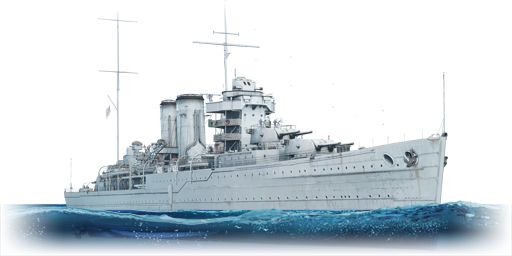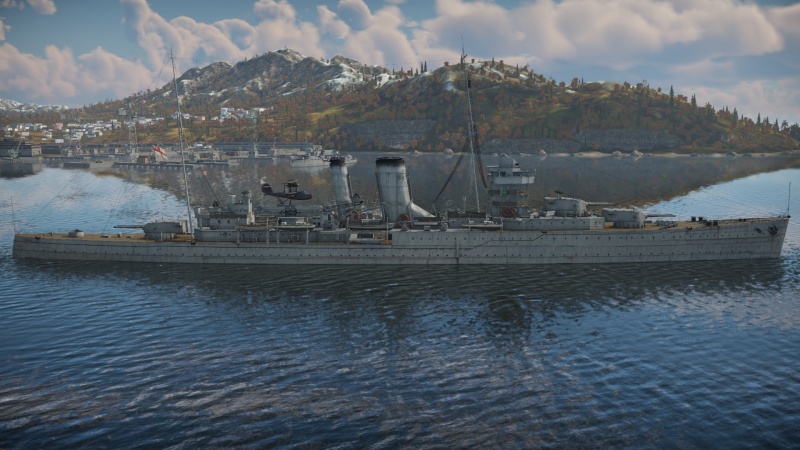HMS York
Contents
Description
The York-class, HMS York (90), 1941 is a rank IV British heavy cruiser with a battle rating of 5.7 (AB/RB/SB). It was introduced in Update "Starfighters".
General info
Survivability and armour
Talk about the vehicle's armour. Note the most well-defended and most vulnerable zones, e.g. the ammo magazine. Evaluate the composition of components and assemblies responsible for movement and manoeuvrability. Evaluate the survivability of the primary and secondary armaments separately. Don't forget to mention the size of the crew, which plays an important role in fleet mechanics. Save tips on preserving survivability for the "Usage in battles" section. If necessary, use a graphical template to show the most well-protected or most vulnerable points in the armour.
Mobility
Write about the ship's mobility. Evaluate its power and manoeuvrability, rudder rerouting speed, stopping speed at full tilt, with its maximum forward and reverse speed.
| Mobility Characteristics | |||
|---|---|---|---|
| Game Mode | Upgrade Status | Maximum Speed (km/h) | |
| Forward | Reverse | ||
| AB | |||
| Upgraded | 70 | 25 | |
| RB/SB | |||
| Upgraded | 60 | 22 | |
Modifications and economy
Armament
Primary armament
Provide information about the characteristics of the primary armament. Evaluate their efficacy in battle based on their reload speed, ballistics and the capacity of their shells. Add a link to the main article about the weapon: {{main|Weapon name (calibre)}}. Broadly describe the ammunition available for the primary armament, and provide recommendations on how to use it and which ammunition to choose.
Secondary armament
Some ships are fitted with weapons of various calibres. Secondary armaments are defined as weapons chosen with the control Select secondary weapon. Evaluate the secondary armaments and give advice on how to use them. Describe the ammunition available for the secondary armament. Provide recommendations on how to use them and which ammunition to choose. Remember that any anti-air armament, even heavy calibre weapons, belong in the next section. If there is no secondary armament, remove this section.
Anti-aircraft armament
An important part of the ship's armament responsible for air defence. Anti-aircraft armament is defined by the weapon chosen with the control Select anti-aircraft weapons. Talk about the ship's anti-air cannons and machine guns, the number of guns and their positions, their effective range, and about their overall effectiveness – including against surface targets. If there are no anti-aircraft armaments, remove this section.
Additional armament
Describe the available additional armaments of the ship: depth charges, mines, torpedoes. Talk about their positions, available ammunition and launch features such as dead zones of torpedoes. If there is no additional armament, remove this section.
Scout plane
Located amidships is a catapult with one Walrus Mk.I scout plane which provides unique offensive and defensive abilities, expanding tactical options. Ship-launched scout planes fly just like regular tree units but lack munition choices and cockpit views. The Walrus is equipped with only defensive machine gun turrets but it does carry 4 x 250 lb bombs. It also has the scout plane ability to cap zones and lay down smoke cover (up to 3 times). Captains will be wise to remember to utilise the aircraft and consider when best to use it, for example to cap a point early or late in the match, to create a smoke screen to stymie enemy bombardment and repair, to attack enemy units directly, or perhaps something completely new! Carrying a far heavier bomb load than other scout planes, this unit has a very good chance to sink enemy boats or even a destroyer.
Usage in battles
The York is very much a sniping cruiser and should be played as such. While it lacks a huge broadside, it makes up for this with a fantastic 5 rounds/per minute RoF, which is one of the best reloads in the game for heavy cruiser firepower. For comparison, the American heavy cruisers fire 3 rounds/per minute, nearly half as quickly. Combined with good shell velocity, this can make the York a frightening opponent for other cruisers, with its guns doing immense damage. Better yet, 2/3rds of the York's firepower is positioned on the bow, meaning it can angle severely and still do a good amount of damage. The York is also a fairly nimble ship, and while it isn't very fast in a straight line, its low weight for a heavy cruiser means it can get up to speed well, and can turn very quickly.
The York suffers once the gap in distance is closed. Its armour is pretty terrible, even for a British cruiser. While the ammo racks are well-protected (and will prove a challenge for anything except other heavy cruisers), its belt armour is very flat and very weak. While its deck armour is strong, it's only rolled armour, meaning arcing shells, bombs, and rockets can do immense damage if they hit the superstructure. The guns are also very weak, with just 25 mm of armour around the turrets, meaning they can be knocked out very easily, even by light cruisers. In addition, the York lacks the beefy AA armament of many other British ships. It has only four 4-inch DP guns, and just a handful of 20 mm and 12.7 mm small arms guns to combat aircraft at close range. Combined with its weak armour, this can make the York an enticing target for aircraft.
Pros and cons
Pros:
- Fantastic rate of fire with its main battery guns can make it a menace in gunnery duels
- Small and nimble, can move around the battlefield very well
- A small target that can be difficult to hit, especially at long range
- Access to torpedoes with good speed and damage, which can ward off flanking cruisers effectively
- Well-armoured ammo racks mean one-shots are only possible for heavy cruisers
- One scout seaplane carrying a potent bomb-load.
Cons:
- Anaemic secondary armament that can leave it vulnerable at close range and against aircraft
- Tiny crew size - fires and flooding can kill it very quickly
- Poor belt and deck armour makes it vulnerable to arcing fire and bombs
History
HMS York (90) was the lead ship of two York-class heavy cruisers built for the Royal Navy. She served in the North American theatre before the war, and escorted Atlantic convoys in the first part of the Second World War. She also participated in the British Norway campaign, and was later reassigned to the Mediterranean Squadron. However, while in service with the Mediterranean fleet, she was disabled by Italian explosive motorboats. Critically damaged, her wreck was abandoned by the Allies. She was salvaged and scrapped in 1952.
Design and development
The York was based on the earlier County-class cruisers, the first 8-inch heavy cruisers used by the United Kingdom. Lighter than the previous 10-thousand ton County-class cruisers, the York displaced 8,250 tons standard.[1] The York carried eight 8-inch (203 mm) guns in four dual turrets; this was the standard armament for later British heavy cruisers.[1]She also carried two triple torpedo tube launchers. Her anti-aircraft armament was rather sparse, and was never improved sufficiently to grant her good AA performance. She could make a top speed of 32 knots (59 km/h), and had an endurance of 24,600 km at 22 km/h.[1]
The York was laid down on May 16th 1927, and was launched on July 17th 1928. She was completed on May 1st 1930, and subsequently began serving with the British home fleet.[2]
Operational Service
The York entered service in 1930, serving as the flagship of the 2nd Cruiser squadron of the Home Fleet. Between 1934 and 1940, she served primarily with the North America/West Indies Station, though she was detached to the Mediterranean fleet for two years for the Italo-Abyssinian War.
At the start of the Second World War, York was based in Halifax as a part of Force F, a squadron tasked with hunting for commerce raiders and escorting convoys. She returned to the UK in late 1939, and underwent a refit before being assigned to the 1st Cruiser squadron of the Home Fleet. She also participated in the planned British invasion of Norway, and evacuated Anglo-French troops from Namsos following the German invasion.
In August of 1940, York was assigned to the 3rd Cruiser squadron of the British Mediterranean fleet. She participated in the Battle of Passero, where she sank the crippled destroyer Artigliere, and escorted the carrier HMS Illustrious during her raid on the Italian fleet at Taranto.[2] However, in early 1941, she was disabled by explosive MTBs of the Italian navy. German bombers further damaged the ship, which was considered to be damaged beyond repair.[2] As a result, the British abandoned the ship and destroyed its armament prior to their evacuation from Crete; the wreck was salvaged and scrapped in 1952.[1]
Media
Excellent additions to the article would be video guides, screenshots from the game, and photos.
See also
Links to articles on the War Thunder Wiki that you think will be useful for the reader, for example:
- reference to the series of the ship;
- links to approximate analogues of other nations and research trees.
External links
References
Works Cited
- Lettens, J. (2008, August 28). HMS York (1941). Retrieved November 16, 2020, from https://www.wrecksite.eu/wreck.aspx?123797
- Helgason, G. (1995). HMS York. Retrieved November 16, 2020, from https://uboat.net/allies/warships/ship/1187.html
| Palmers Shipbuilding and Iron Company | |
|---|---|
| Light Cruisers | |
| Town-class | HMS York |
| Battlecruisers | |
| Unique ships | HMS Queen Mary |
| Britain heavy cruisers | |
|---|---|
| Hawkins-class | HMS Hawkins |
| York-class | HMS York |
| County-class | HMS Kent · HMS London · HMS Norfolk |






